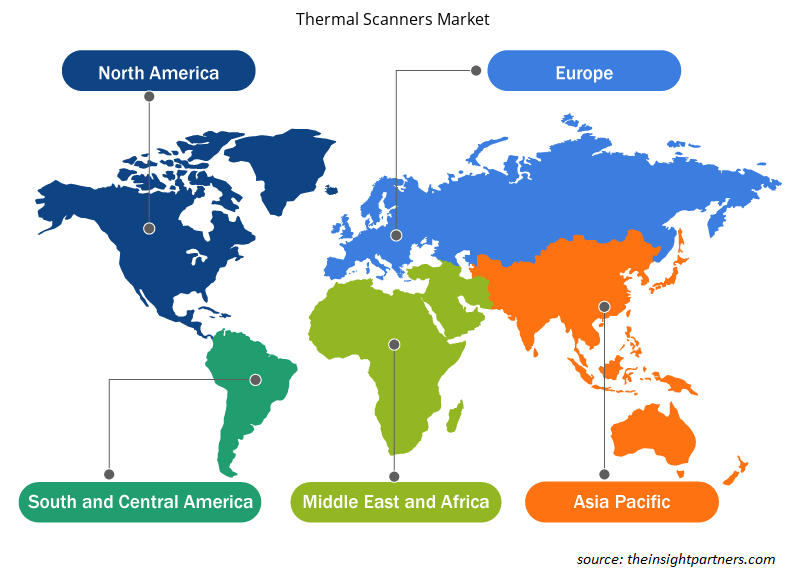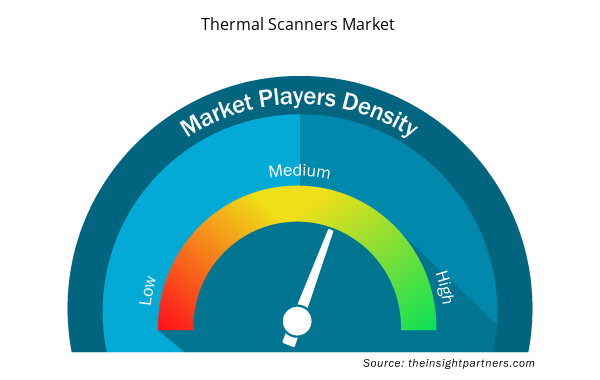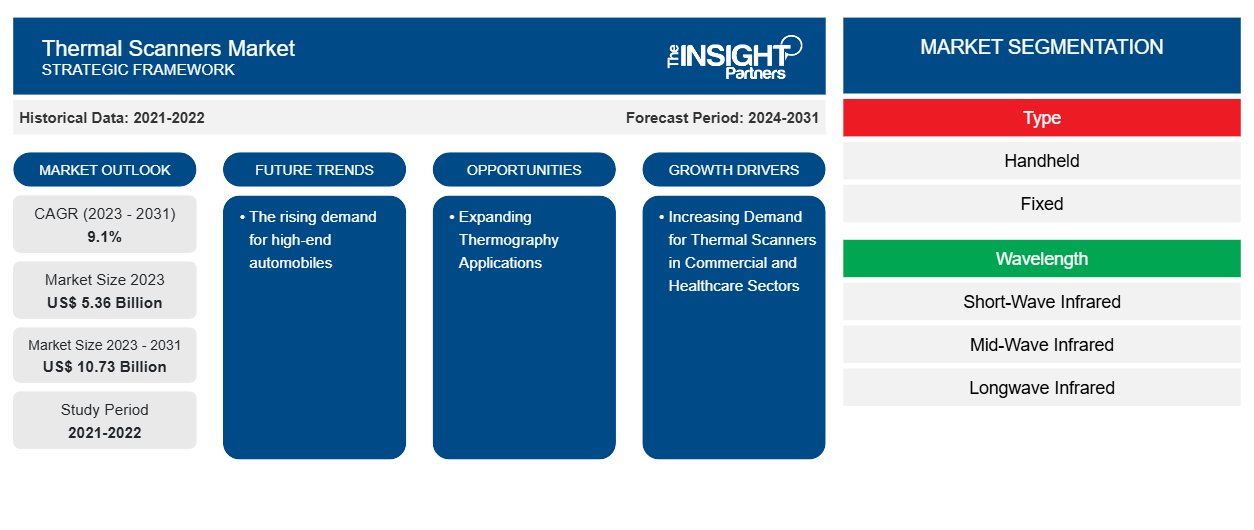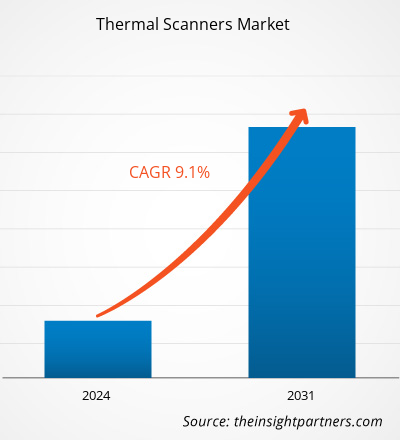サーマルスキャナーの市場規模は、2023年の53億6,000万米ドルから2031年には107億3,000万米ドルに達すると予測されています。市場は 2023年から2031年にかけて9.1%のCAGRを記録すると予想されています。高級自動車の需要の高まりは、サーマルスキャナー市場の重要なトレンドであり続けると思われます。
サーマルスキャナ市場分析
サーマル スキャナー市場は、商業および医療分野でのサーマル スキャナーの需要の増加と、革新的なサーマル スキャナーの開発に向けた研究開発への投資の増加により、急速に成長しています。市場は、空港、病院、その他のさまざまな公共の場所で検出目的での設置の増加に牽引されて着実に拡大しています。さらに、サーモグラフィーアプリケーションの拡大、技術の進歩、人工知能と顔認識技術の統合により、市場の成長に有利な機会が生まれています。
サーマルスキャナ市場の概要
赤外線サーマル スキャナーは、あらゆる物体から発生する熱を検出し、それを電気信号に変換する非侵襲性の画像化機器です。その用途は、産業オペレーション、治療センター、研究室、警察執行など、さまざまな環境で時間とともに拡大してきました。多くの用途の多様化と成長により、近年、いくつかの経済圏でサーマル スキャナーの売上が増加しています。
要件に合わせてレポートをカスタマイズする
このレポートの一部、国レベルの分析、Excelデータパックなど、あらゆるレポートを無料でカスタマイズできます。また、スタートアップや大学向けのお得なオファーや割引もご利用いただけます。
- このレポートの主要な市場動向を入手してください。この無料サンプルには、市場動向から見積もりや予測に至るまでのデータ分析が含まれます。
サーマルスキャナ市場の推進要因と機会
商業および医療分野でのサーマルスキャナの需要増加が市場を牽引
サーマル スキャナーは、セキュリティおよび監視アプリケーションとして商業および医療分野で需要が高いです。従業員と居住者のセキュリティ強化に対する高いニーズに関連するセキュリティおよび監視アプリケーションのニーズの高まりが、市場を牽引しています。サーマル スキャナーは、CCTVシステムと比較して低コストで利用できるため、ユーザーに高い投資収益率 ( ROI ) を提供します。サーマル カメラ ベースのセキュリティ システムの総設置コストは、CCTV システムよりもはるかに低いため、商業および医療分野での採用が増加しています。ただし、商業および医療分野によるインフラストラクチャ システムへの投資の増加と、専門的な監視の必要性が相まって、市場を牽引すると予想されます。
サーモグラフィーの用途拡大- サーマルスキャナ市場におけるチャンス
サーモグラフィーは、血圧の監視、心臓手術、肝臓病の診断、乳がんの検出など、医療業界で広く使用されています。サーモグラフィーアプリケーションでは、サーマルスキャナーに搭載された赤外線カメラを使用して、体組織の血流と熱パターンを検出します。さらに、医療業界からの支出の増加と、高度なサーマルスキャナーの開発に向けた研究開発活動の増加により、予測期間中に市場に大きな成長の機会が生まれています。
サーマルスキャナ市場レポートのセグメンテーション分析
サーマル スキャナー市場分析の導出に貢献した主要なセグメントは、タイプ、波長、および最終用途です。
- タイプに基づいて、サーマルスキャナー市場はハンドヘルドと固定に分かれています。固定セグメントは2023年に大きな市場シェアを占めました。
- 波長に基づいて、サーマルスキャナー市場は、短波赤外線、中波赤外線、長波赤外線に分けられます。長波赤外線セグメントは、2023年に大きな市場シェアを占めました。longwave infrared. The longwave infrared segment held a larger market share in 2023.
- 最終用途別に見ると、市場は産業、航空宇宙・防衛、自動車、石油・ガス、その他に分類されます。航空宇宙・防衛セグメントは2023年に大きな市場シェアを占めました。
サーマルスキャナ市場シェア分析(地域別)
サーマル スキャナー市場レポートの地理的範囲は、主に北米、アジア太平洋、ヨーロッパ、中東およびアフリカ、南米/中南米の 5 つの地域に分かれています。収益面では、航空宇宙および防衛産業の拡大により、北米がサーマル スキャナー市場で最大のシェアを占めています。
アジア太平洋地域の市場は、多くのベンダーが低コストのソリューションを提供しているため、エンドユーザーの間でサーマルスキャナーの需要が高まり、近い将来に拡大すると予想されています。工業、航空宇宙および防衛、自動車、石油およびガスなど、多くの業界の投資の増加と拡大により、市場にチャンスが生まれています。これらの業界では、監視目的でサーマルスキャナーを積極的に採用しており、大量生産が促進されています。そのため、予測期間中に市場が拡大するでしょう。
サーマルスキャナ市場の地域別分析
予測期間を通じてサーマル スキャナー市場に影響を与える地域的な傾向と要因は、Insight Partners のアナリストによって徹底的に説明されています。このセクションでは、北米、ヨーロッパ、アジア太平洋、中東、アフリカ、南米、中米にわたるサーマル スキャナー市場のセグメントと地理についても説明します。

- サーマルスキャナ市場の地域別データを入手
サーマルスキャナ市場レポートの範囲
| レポート属性 | 詳細 |
|---|---|
| 2023年の市場規模 | 53億6千万米ドル |
| 2031年までの市場規模 | 107.3億米ドル |
| 世界のCAGR(2023年~2031年) | 9.1% |
| 履歴データ | 2021-2022 |
| 予測期間 | 2024-2031 |
| 対象セグメント | タイプ別
|
| 対象地域と国 | 北米
|
| 市場リーダーと主要企業プロフィール |
|
サーマルスキャナ市場のプレーヤー密度:ビジネスダイナミクスへの影響を理解する
サーマル スキャナー市場は、消費者の嗜好の変化、技術の進歩、製品の利点に対する認識の高まりなどの要因により、エンド ユーザーの需要が高まり、急速に成長しています。需要が高まるにつれて、企業は提供内容を拡大し、消費者のニーズを満たすために革新を起こし、新たなトレンドを活用し、市場の成長をさらに促進しています。
市場プレーヤー密度とは、特定の市場または業界内で活動している企業または会社の分布を指します。これは、特定の市場スペースに、その規模または総市場価値と比較して、どれだけの競合相手 (市場プレーヤー) が存在するかを示します。
サーマルスキャナ市場で事業を展開している主要企業は次のとおりです。
- FLIRシステムズ株式会社
- アメテック株式会社
- ロバート・ボッシュ GmbH
- 3M
- レオナルド
- エレクトロオプティカルインダストリーズ
免責事項:上記の企業は、特定の順序でランク付けされていません。

- サーマルスキャナ市場のトップキープレーヤーの概要を入手
サーマルスキャナ市場のニュースと最近の動向
サーマル スキャナー市場は、主要な企業出版物、協会データ、データベースなどの一次調査と二次調査後の定性的および定量的データを収集することで評価されます。以下は、サーマル スキャナー市場の動向と戦略の一覧です。
- 2024 年 1 月、Valeo と Teledyne FLIR は、夜間視認 ADAS 向けの初の自動車安全度水準 (ASIL) B サーマル イメージング技術を提供します。このシステムは、Valeo の幅広いセンサーを補完し、乗用車や商用車、自律走行車の夜間の自動緊急ブレーキ (AEB) などの機能をサポートする Valeo の ADAS ソフトウェア スタックを活用します。(出典: Valeo、プレス リリース、2024 年)
サーマルスキャナ市場レポートの対象範囲と成果物
「サーマルスキャナー市場規模と予測(2021〜2031年)」レポートでは、以下の分野をカバーする市場の詳細な分析を提供しています。
- 対象範囲に含まれるすべての主要市場セグメントの世界、地域、国レベルでの市場規模と予測
- 市場の動向(推進要因、制約、主要な機会など)
- 今後の主な動向
- 詳細なPEST/ポーターの5つの力とSWOT分析
- 主要な市場動向、主要プレーヤー、規制、最近の市場動向を網羅した世界および地域の市場分析
- 市場集中、ヒートマップ分析、主要プレーヤー、最近の動向を網羅した業界の状況と競争分析
- 詳細な企業プロフィール
- 過去2年間の分析、基準年、CAGRによる予測(7年間)
- PEST分析とSWOT分析
- 市場規模価値/数量 - 世界、地域、国
- 業界と競争環境
- Excel データセット



Report Coverage
Revenue forecast, Company Analysis, Industry landscape, Growth factors, and Trends

Segment Covered
This text is related
to segments covered.

Regional Scope
North America, Europe, Asia Pacific, Middle East & Africa, South & Central America

Country Scope
This text is related
to country scope.
よくある質問
The incremental growth expected to be recorded for the global thermal scanners market during the forecast period is US$ 5.37 billion.
The key players holding majority shares in the global thermal scanners market are FLIR Systems, Inc., AMETEK Inc., Robert Bosch GmbH, 3M, and Leonardo.
The global thermal scanners market is expected to reach US$ 10.73 billion by 2031.
The rising demand for high-end automobiles to play a significant role in the global thermal scanners market in the coming years.
The increasing demand for thermal scanners in commercial and healthcare sectors and increasing investment in research & development for developing innovative thermal scanners are the major factors that propel the global thermal scanners market.
The global thermal scanners market was estimated to be US$ 5.36 billion in 2023 and is expected to grow at a CAGR of 9.1% during the forecast period 2023 - 2031.
Trends and growth analysis reports related to Electronics and Semiconductor : READ MORE..
The Insight Partners performs research in 4 major stages: Data Collection & Secondary Research, Primary Research, Data Analysis and Data Triangulation & Final Review.
- Data Collection and Secondary Research:
As a market research and consulting firm operating from a decade, we have published and advised several client across the globe. First step for any study will start with an assessment of currently available data and insights from existing reports. Further, historical and current market information is collected from Investor Presentations, Annual Reports, SEC Filings, etc., and other information related to company’s performance and market positioning are gathered from Paid Databases (Factiva, Hoovers, and Reuters) and various other publications available in public domain.
Several associations trade associates, technical forums, institutes, societies and organization are accessed to gain technical as well as market related insights through their publications such as research papers, blogs and press releases related to the studies are referred to get cues about the market. Further, white papers, journals, magazines, and other news articles published in last 3 years are scrutinized and analyzed to understand the current market trends.
- Primary Research:
The primarily interview analysis comprise of data obtained from industry participants interview and answers to survey questions gathered by in-house primary team.
For primary research, interviews are conducted with industry experts/CEOs/Marketing Managers/VPs/Subject Matter Experts from both demand and supply side to get a 360-degree view of the market. The primary team conducts several interviews based on the complexity of the markets to understand the various market trends and dynamics which makes research more credible and precise.
A typical research interview fulfils the following functions:
- Provides first-hand information on the market size, market trends, growth trends, competitive landscape, and outlook
- Validates and strengthens in-house secondary research findings
- Develops the analysis team’s expertise and market understanding
Primary research involves email interactions and telephone interviews for each market, category, segment, and sub-segment across geographies. The participants who typically take part in such a process include, but are not limited to:
- Industry participants: VPs, business development managers, market intelligence managers and national sales managers
- Outside experts: Valuation experts, research analysts and key opinion leaders specializing in the electronics and semiconductor industry.
Below is the breakup of our primary respondents by company, designation, and region:

Once we receive the confirmation from primary research sources or primary respondents, we finalize the base year market estimation and forecast the data as per the macroeconomic and microeconomic factors assessed during data collection.
- Data Analysis:
Once data is validated through both secondary as well as primary respondents, we finalize the market estimations by hypothesis formulation and factor analysis at regional and country level.
- Macro-Economic Factor Analysis:
We analyse macroeconomic indicators such the gross domestic product (GDP), increase in the demand for goods and services across industries, technological advancement, regional economic growth, governmental policies, the influence of COVID-19, PEST analysis, and other aspects. This analysis aids in setting benchmarks for various nations/regions and approximating market splits. Additionally, the general trend of the aforementioned components aid in determining the market's development possibilities.
- Country Level Data:
Various factors that are especially aligned to the country are taken into account to determine the market size for a certain area and country, including the presence of vendors, such as headquarters and offices, the country's GDP, demand patterns, and industry growth. To comprehend the market dynamics for the nation, a number of growth variables, inhibitors, application areas, and current market trends are researched. The aforementioned elements aid in determining the country's overall market's growth potential.
- Company Profile:
The “Table of Contents” is formulated by listing and analyzing more than 25 - 30 companies operating in the market ecosystem across geographies. However, we profile only 10 companies as a standard practice in our syndicate reports. These 10 companies comprise leading, emerging, and regional players. Nonetheless, our analysis is not restricted to the 10 listed companies, we also analyze other companies present in the market to develop a holistic view and understand the prevailing trends. The “Company Profiles” section in the report covers key facts, business description, products & services, financial information, SWOT analysis, and key developments. The financial information presented is extracted from the annual reports and official documents of the publicly listed companies. Upon collecting the information for the sections of respective companies, we verify them via various primary sources and then compile the data in respective company profiles. The company level information helps us in deriving the base number as well as in forecasting the market size.
- Developing Base Number:
Aggregation of sales statistics (2020-2022) and macro-economic factor, and other secondary and primary research insights are utilized to arrive at base number and related market shares for 2022. The data gaps are identified in this step and relevant market data is analyzed, collected from paid primary interviews or databases. On finalizing the base year market size, forecasts are developed on the basis of macro-economic, industry and market growth factors and company level analysis.
- Data Triangulation and Final Review:
The market findings and base year market size calculations are validated from supply as well as demand side. Demand side validations are based on macro-economic factor analysis and benchmarks for respective regions and countries. In case of supply side validations, revenues of major companies are estimated (in case not available) based on industry benchmark, approximate number of employees, product portfolio, and primary interviews revenues are gathered. Further revenue from target product/service segment is assessed to avoid overshooting of market statistics. In case of heavy deviations between supply and demand side values, all thes steps are repeated to achieve synchronization.
We follow an iterative model, wherein we share our research findings with Subject Matter Experts (SME’s) and Key Opinion Leaders (KOLs) until consensus view of the market is not formulated – this model negates any drastic deviation in the opinions of experts. Only validated and universally acceptable research findings are quoted in our reports.
We have important check points that we use to validate our research findings – which we call – data triangulation, where we validate the information, we generate from secondary sources with primary interviews and then we re-validate with our internal data bases and Subject matter experts. This comprehensive model enables us to deliver high quality, reliable data in shortest possible time.


 このレポートの無料サンプルを入手する
このレポートの無料サンプルを入手する